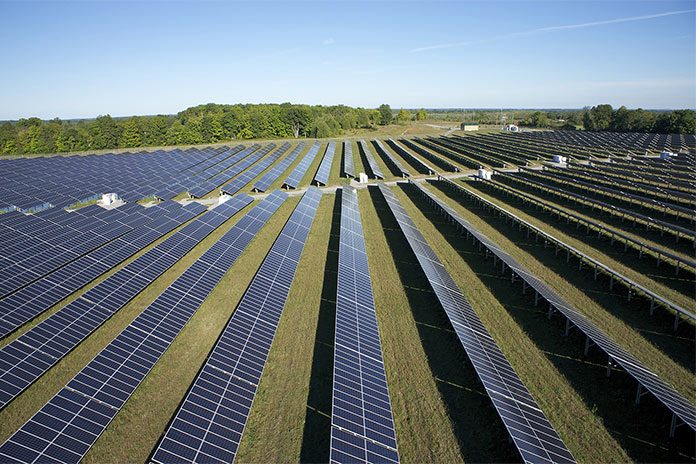
A proposed 600-acre, 75-megawatt solar farm west of Boardman would become the largest such facility in Oregon – by far.
As of early 2017, Oregon’s largest commercial solar facility is the 5 MW Outback Solar Project, located near Lakeview. Other large commercial facilities include the 2.9 MW Steel Bridge Solar facility near Willamina and the 1.75 MW Baldock facility installed by the Oregon Department of Transportation near Wilsonville.
Umatilla Electric’s solar array near McNary, installed in early 2016, produces 1 megawatt of energy at peak production.
For the past 15 years, Oregon’s renewable energy development sector has been dominated by wind power. The market is shifting as solar PV has become more cost-competitive and utilities look to diversify their resources. Commercial solar is priced below $3 per watt, or about two-thirds less than cost-per-watt in 2006, Oregon DOE reported in an online post.

Invenergy, a renewable energy company headquartered in Chicago, had requested and ODOE approved that the project go through what’s defined in state law as an “expedited review” because it meets the qualification of being less than 100 MW.
Invenergy LLC is the parent company of Invenergy Solar Development LLC, and Invenergy Solar Development LLC is the parent company of Boardman Solar Energy LLC, which is the applicant.
Generally speaking, local governments have jurisdiction over smaller proposed energy projects, while larger projects are overseen at the state or federal level. For some energy projects, jurisdiction is based on the energy output; for solar projects, the physical size of the facility determines jurisdiction. Oregon’s Energy Facility Siting Council, staffed by ODOE, has jurisdiction over solar PV installations that are proposed on at least 100 acres of high-value agricultural land or other cultivated land or at least 320 acres for all other lands, ODOE reported.
In preparation for review of the facility, at its Jan. 19, 2017 meeting the Council appointed the governing bodies of two impacted Oregon counties, Morrow and Gilliam, as Special Advisory Groups. Various state and county permits and approvals would be required.
The Boardman array would use multiple 355-watt photovoltaic solar panels. Related or supporting facilities would include the energy collection system, 34.5-kV/115-kV generator step-up transformer and substation, 115-kV transmission line, point of interconnection line tap, control house, O&M building, a private main access road, private service roads and gates, a temporary staging area and a temporary concrete batch plant. The O&M building would be about 3,000 square feet.
Access to the Facility would be from Threemile Canyon Road, which is a paved private road that runs north and south just east of the Facility from Interstate 84 at Exit 151. A turnoff for the Willow Creek Wildlife Area is located 0.5 mile south on the west side of Threemile Canyon Road.
In addition to its home office in Chicago, Invenergy has regional development offices in the United States, Canada, Mexico, Japan and Europe.
Invenergy and its affiliated companies have developed more than 15,000 MW of projects that are in operation, construction or advanced development, including wind, solar, natural gas-fueled power generation and energy storage projects. For more information, please visit www.invenergyllc.com.









